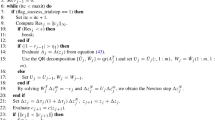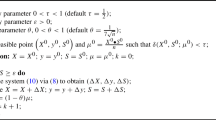Abstract
In this paper, an inexact non-interior continuation method is proposed for semidefinite Programs. By a matrix mapping, the primal-dual optimal condition can be inverted into a smoothed nonlinear system of equations. A linear system of equations with residual vector is eventually driven by solving the smoothed nonlinear system of equations and finally solved by the conjugate residual method. The global and locally superlinear convergence are verified. Numerical results and comparisons indicate that the proposed methods are very promising and comparable to several interior-point and other exact non-interior continuation methods.
Similar content being viewed by others
References
Alizadeh F.: Interior point methods in semidefinite programming with application to combinatorial optimization. SIAM J. Optim. 5, 13–51 (1995)
Alizadeh, F., Haeberly, J.-P., Overton M.L.: Primal-dual interior-point methods for semidefinite programming: Convergence rates, stability and numerical results. SIAM J. Optim. 8, 746–68 (1998)
Bellavia, S., Pieraccini, S.: Convergence Analysis of an inexact infeasible interior point mehtod for semidefinite programming. Comput. Optim. Appl. 29, 289–313 (2004)
Bartels, R.H., Stewart, G.W.: Solution of the Matrix Equation AX + XB = C. Communications of the ACM 15(9), 820–826 (1972)
Benson, S., Ye, Y., Zhang, X.: Solving large-scale sparse semidefinite programs for combinatorial optimization, vol. 10, pp. 443–461 (2000)
Borchers, B.: SDPLIB 1.2, A Library of Semidefinite Programming Test Problems. Optim. Methods Softw. 11, 597–611 (1999)
Chen, X., Qi, H., Tseng, P.: Analysis of nonsmooth symmetric-matrix functions with applications to semidefinite complementarity problems. SIAM J. Optim. 13, 960–985 (2003)
Chen, X., Tseng, P.: Non-interior continuation methods for solving semidefinite complementarity problems. Math. Program. 95, 431–474 (2003)
Helmberg, C., Rendl, F., Vanderbei, R.J., Wolkowicz, H.: An interior-point method for semidefinite programming. SIAM J. Optim. 6, 342–361 (1996)
Golub, G.H., Nash, S., Van Loan, C.F.: A Hessenberg-Schur method for the problem AX + XB = C. IEEE Trans. Auto. Contr. AC-24, 909–913 (1979)
Kanzow, C., Nagel, C.: Semidefinite programs: new search directions, smoothing-type methods, and numerical results. SIAM J. Optim. 13, 1–23 (2002)
Kanzow, C., Nagel, C.: Some Practical Aspects of a Newton-Type Method for Semidefinite Programs. Preprint 243. Institute of Applied Mathematics and Statistics, Germany (2001)
Kojima, M., Shida, M., Shindoh, S.: Local convergence of predictor-corrector infeasible interior-point algorithms for SDPs and SDLCPs, vol. 80, pp. 129–160 (1998)
Kojima, M., Shindoh, S., Hara, S.: Interior-point methods for the monotone semidefinite linear complementarity problems. SIAM J. Optim. 7, 86–125 (1997)
Monteiro, R.D.C.: Primal-dual path following algorithms for semidefinite programming. SIAM J. Optim. 7, 663–678 (1997)
Nesterov, Y.E., Nemirovsky, A.: Interior-point polynomial methods in convex programming. Volume 13 of Studies in Applied Mathematics SIAM, Philadelphia, PA (1994)
Nesterov, Y.E., Todd, M.J.: Self-scaled barriers and interior-point methods for convex programming. Math Oper. Res. 22, 1–42 (1997)
Nesterov, Y.E., Todd, M.J.: Primal-dual interior-point methods for self-scaled cones. SIAM J. Optim. 8, 324–364 (1998)
Nakata, K., Zhang, S.-L., Kojima, M.: Preconditioned Conjugate Gradient Methods for Large Scale and Dense Linear Systems in Semidefinite Programming, abstract based on talks delivered at INFORMS Meeting. Philadelphia (1999)
Penzl, T.: Numerical solution of generalized Lyapunov equations. Adv. Comput. Math. 8, 33–48 (1998)
Qi, L.: Convergence analysis of some algorithms for solving nonsmooth equations. Math. Oper. Res. 18, 227–244 (1993)
Qi, L., Sun, D., Zhou, G.: A new look at smoothing Newton methods for nonlinear comple- mentarity problems and box constrained variational inequalities. Math. Prog. 87, 1–35 (2000)
Saad, Y.: Iterative Methods for Sparse Linear Systems. PWS PublishingCompany, Boston (1996)
Sun, D., Sun, J.: Semismooth matrix valued functions. Math. Oper. Res. 27, 150–169 (2002)
Sun, J., Sun, D., Qi, L.: A squared smoothing Newton method for nonsmooth matrix equations and its applications in semidefinite optimization problems, vol. 14, pp. 783–806 (2004)
Toh, K.C.: Solving some large semidefinite programs via the conjugate residual method, vol. 12, pp. 669–691 (2002)
Toh, K.-C., Todd, M.J., Tutuncu, R.H.: SDPT3 version 4.0 (beta) – a MATLAB software for semidefinite-quadratic-linear programming. Available: http://www.math.nus.edu.sg/mattohkc/sdpt3.html (2004)
Todd, M.J.: On search directions in interior-point methods for semidefinite programming. Optim. Methods Softw. 11, 1–46 (1999)
Tseng, P.: Analysis of a non-interior continuation method based on Chen-Mangasarian smoothing functions for complementarity problems. In: Fukushima, M., Qi, L. (eds.) Reformulation C Nonsmooth, Piecewise Smooth, Semismooth and Smoothing Methods, pp. 381–404. KluwerAcademic Publishers, Boston (1999)
Tseng, P.: Merit functions for semi-definite complementarity problems. Math. Program. 83, 159–85 (1998)
Vandenberghe, L., Boyd, S.: Semidefinite programming. SIAM Rev. 38, 49–95 (1996)
Wolkowicz, H., Saigal, R., Vandenberghe, L.: Handbook of semidefinite programming. KluwerAcademic Publishers, Boston-Dordrecht-London (2000)
Yang, X., Zhang, Y., Liu, H., Pei, Y.: A Mizuno-Todd-Ye predictor-corrector infeasible-interior-point method for linear programming over symmetric cones. Numerical Algorithms. In press, available at: http://link.springer.com/article/10.1007/s11075-015-0074-7 (2015)
Zhang, Y.: On extending some primal-dual interior-point algorithms from linear programming to semidefinite programming. SIAM J. Optim. 8, 365–386 (1998)
Zhou, G., Toh, K.: Polynomiality of an inexact infeasible interior point algorithm for semidefinite programming, vol. 99, pp. 261–282 (2004)
Author information
Authors and Affiliations
Corresponding author
Rights and permissions
About this article
Cite this article
Ling, A. An inexact non-interior continuation method for semidefinite programming: convergence analysis and numerical results. Numer Algor 73, 219–244 (2016). https://doi.org/10.1007/s11075-015-0093-4
Received:
Accepted:
Published:
Issue Date:
DOI: https://doi.org/10.1007/s11075-015-0093-4




